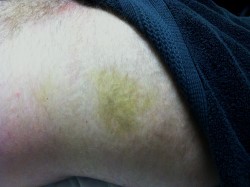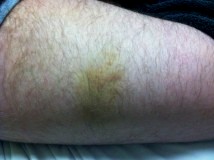In our clinic we frequently work with patients who’ve suffered from incorrectly applied massage therapy. Two days ago we had a very disturbing case – a 35 year old male with tetraplegia (partial paralysis of all extremities) as a result of severe neck trauma on the level C6-C7 with partial damage of the spinal cord, which happened 15 years ago. He walks with a walker and suffers from flaccid palsy with elements of severe uncontrollable spasticity, especially in the lower extremities. He has decreased muscle tone and diminished sensitivity to touch or noxious (pain) stimuli.
Three weeks ago a special inflatable seat cushion collapsed under him. After impact he started to feel tension and moderate pain in his left gluteal area, which affected the sitting required for his job as a computer programmer.
To reduce the uncomfortable sensations he went to a massage therapist who worked on his lower back left gluteal area and left posterior thigh, using what she called “very deep massage work.” The next day he was in absolutely excruciating pain without any chance to sit at all. His entire buttock and thigh were black and blue. Here are pics we took of the patient two and half weeks (!!!) after his experience with the ‘healing touch.’


As you can see, intense hematomas are still present on the buttocks and thigh even after two weeks. In addition to his inability to sit after the massage session he developed very unpleasant sensations in his left scrotum. One visible hematoma was located at the entrance of the pudendal nerve into the pudendal canal. The pudendal nerve is responsible for the innervation of external sex organs.
The therapist saw that she was dealing with a quadriplegic client whose soft tissues are much more fragile and his pain threshold is lower than a healthy individual. He told her that his pain started just after the seat cushion collapse. For what reason would the therapist apply deep tissue pressure, severely damaging soft tissues and even triggering Pudendal Nerve Neuralgia?
This is a situation when the therapist should voluntarily surrender her massage license or have it taken from her. As long as such ‘therapists’ continue to practice, massage therapy will never be part of modern medicine. In our research we have gathered a grim collection of articles published in medical journals where physicians reported cases of severe complications from massage therapy – from activation of shingles to ossificated hematoma and various neuralgias.
LESSONS:
1. It doesn’t matter what you were taught or what you believe, the clinical truth is indisputable.
In the clinical application of massage therapy there is no such modality as deep tissue massage. Application of excessive pressure while the patient is already in pain is a sign of professional incompetence.
2. Pressure is a precious treatment tool, but at the same time it can be extremely harmful stimuli. The therapist must have enough basic training to use pressure wisely and not senselessly press into the soft tissues of the patient’s body.
3. All pressure during the treatment of the patient must be applied just below the pain threshold level. This matter must be constantly communicated with the patient. It allows you to adjust and slowly increase the applied pressure without activating the pain analyzing system.
4. Even in the stress reduction massage field deep tissue massage is not an independent modality. The difference between a regular Swedish Massage session and a deep tissue massage session is only the degree of applied pressure. This is completely acceptable in cases of healthy clients but it is completely unacceptable during work with patients.
Category: Blog , News
